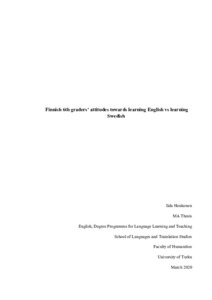Finnish 6th graders’ attitudes towards learning English vs learning Swedish
Honkonen, Iida (2020-03-27)
Finnish 6th graders’ attitudes towards learning English vs learning Swedish
Honkonen, Iida
(27.03.2020)
Julkaisu on tekijänoikeussäännösten alainen. Teosta voi lukea ja tulostaa henkilökohtaista käyttöä varten. Käyttö kaupallisiin tarkoituksiin on kielletty.
avoin
Julkaisun pysyvä osoite on:
https://urn.fi/URN:NBN:fi-fe2020050825791
https://urn.fi/URN:NBN:fi-fe2020050825791
Tiivistelmä
In this master’s thesis, 6th grade students’ attitudes towards learning English and Swedish were studied. The aim was to find out if the students preferred one language to the other and also to see if there is a difference in the attitudes between boys and girls.
The participants in the study were 92 6th grade students (age 11–12), who answered questionnaires about their attitudes to learning English and Swedish. For background information, age and gender of the participants were asked. The participants filled in one questionnaire about their attitudes to learning English and another questionnaire about their attitudes to learning Swedish. The questions in the questionnaires were same regarding both languages and both questionnaires included eight questions. The same students answered the questionnaire twice; first about their attitudes to learning English and then about their attitudes to learning Swedish. The questionnaire had open and closed questions, Likert-scale questions and multiple choice questions. The results were analyzed by using a computer programme SPSS and content analysis. The interest to study this topic was created by the reform of the national core curriculum for basic education. In the new national core curriculum, Swedish is taught already from 6th grade on (age 11–12), instead of 7th grade on (age 13–14). In addition, English was previously taught from 3rd grade on at the latest (age 8–9) but is now taught from 1st grade on (age 6–7).
The results of the study showed that the students’ attitudes to learning English were mostly positive, and English was seen as an important and useful language. Students also used and heard English a lot in their free time. There were no major differences in the attitudes to learning English between boys and girls. Furthermore, the results indicated that attitudes to learning Swedish were not as positive. Swedish was not seen as a very useful language, and students mostly saw it being helpful when travelling to Sweden. Some students also argued that they do not need Swedish, because they can use English instead. Boys’ attitudes were somewhat less positive to learning Swedish than girls’, but the differences were, however, minor. The results of the study offer information about primary school students’ attitudes to language learning. In the future, more studies about the effects of early language teaching are needed in order to find out how early teaching of English and Swedish affects students’ attitudes towards those languages.
The participants in the study were 92 6th grade students (age 11–12), who answered questionnaires about their attitudes to learning English and Swedish. For background information, age and gender of the participants were asked. The participants filled in one questionnaire about their attitudes to learning English and another questionnaire about their attitudes to learning Swedish. The questions in the questionnaires were same regarding both languages and both questionnaires included eight questions. The same students answered the questionnaire twice; first about their attitudes to learning English and then about their attitudes to learning Swedish. The questionnaire had open and closed questions, Likert-scale questions and multiple choice questions. The results were analyzed by using a computer programme SPSS and content analysis. The interest to study this topic was created by the reform of the national core curriculum for basic education. In the new national core curriculum, Swedish is taught already from 6th grade on (age 11–12), instead of 7th grade on (age 13–14). In addition, English was previously taught from 3rd grade on at the latest (age 8–9) but is now taught from 1st grade on (age 6–7).
The results of the study showed that the students’ attitudes to learning English were mostly positive, and English was seen as an important and useful language. Students also used and heard English a lot in their free time. There were no major differences in the attitudes to learning English between boys and girls. Furthermore, the results indicated that attitudes to learning Swedish were not as positive. Swedish was not seen as a very useful language, and students mostly saw it being helpful when travelling to Sweden. Some students also argued that they do not need Swedish, because they can use English instead. Boys’ attitudes were somewhat less positive to learning Swedish than girls’, but the differences were, however, minor. The results of the study offer information about primary school students’ attitudes to language learning. In the future, more studies about the effects of early language teaching are needed in order to find out how early teaching of English and Swedish affects students’ attitudes towards those languages.
